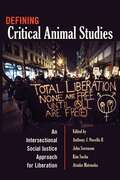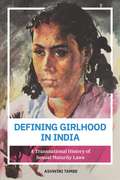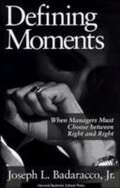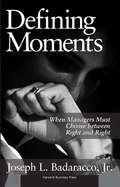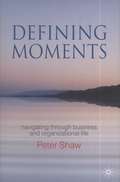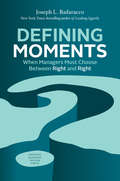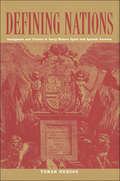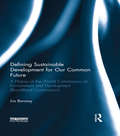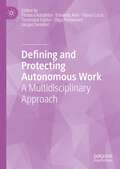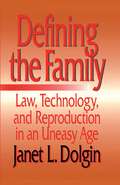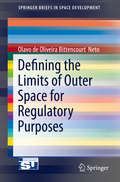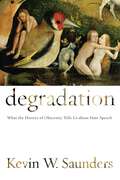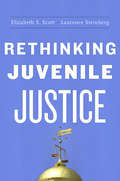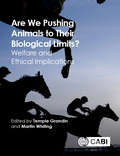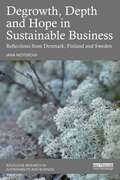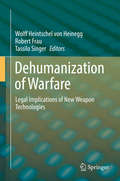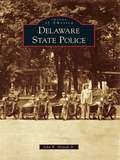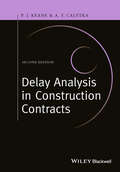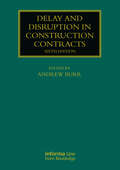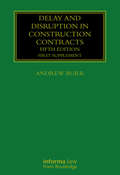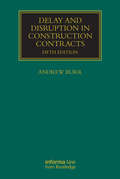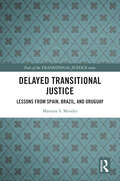- Table View
- List View
Defining Critical Animal Studies: An Intersectional Social Justice Approach for Liberation
by Anthony J. Nocella II John Sorenson Atsuko Matsuoka Kim SochaThis is the first book to define the philosophical and practical parameters of critical animal studies (CAS). Rooted in anarchist perspectives that oppose all systems of domination and authoritarianism, CAS both challenges anthropocentrism and presents animal liberation as a social justice movement that intersects with other movements for positive change. Written by a collection of internationally respected scholar-activists, each chapter expands upon the theory and practice underlying the total liberation approach, the roles of academics and activists, and the ten principles of CAS. With apolitical animal studies and exploitative animal research dominating higher education, this book offers a timely counter-narrative that demands the liberation of all oppressed beings and the environment. Defining Critical Animal Studies will interest educators, students, activists, community members, and policy makers seeking accessible theory that can be put into action.
Defining Girlhood in India: A Transnational History of Sexual Maturity Laws
by Ashwini TambeAt what age do girls gain the maturity to make sexual choices? This question provokes especially vexed debates in India, where early marriage is a widespread practice. India has served as a focal problem site in NGO campaigns and intergovernmental conferences setting age standards for sexual maturity. Over the last century, the country shifted the legal age of marriage from twelve, among the lowest in the world, to eighteen, at the high end of the global spectrum. Ashwini Tambe illuminates the ideas that shaped such shifts: how the concept of adolescence as a sheltered phase led to delaying both marriage and legal adulthood; how the imperative of population control influenced laws on marriage age; and how imperial moral hierarchies between nations provoked defensive postures within India. Tambe takes a transnational feminist approach to legal history, showing how intergovernmental debates influenced Indian laws and how expert discourses in India changed UN terminology about girls. Ultimately, Tambe argues, the well-meaning focus on child marriage has been tethered less to the interests of girls themselves and more to parents’ interests, achieving population control targets, and preserving national reputation.
Defining Moments
by Joseph BadaraccoMaking decisions when there is a clear choice between "right" and "wrong" is easy. Making decisions where the choice is between "right" and "right" is not. This book lays out a series of general principles and guidelines, drawn from ancient and modern Western philosophy, which can help managers and leaders chart a course through the thickets of conflicting values and moral choices which make up all "right versus right" decisions.
Defining Moments
by Joseph L. Badaracco Jr."Defining moments," according to Badaracco, occur when managers face business problems that trigger difficult, deeply personal questions. In deciding how to act, managers reveal their inner values, test their commitment to those values, and ultimately shape their characters. Badaracco builds a framework for approaching these dilemmas around three cases of increasing complexity, reflecting the escalating responsibilities managers face as they advance in their careers. The first story presents a young man whose choice will affect him only as an individual; the second, a department head, whose decision will influence his organization; the third, a corporate executive, whose actions will have much larger, societal ramifications. To guide the decision-making process, Badaracco draws on the insights of four philosophers--Aristotle, Machiavelli, Nietzsche, and James--because they offer practical rather than theoretical advice. He thus bridges the gap between classroom philosophy and corporate pragmatism. The result is a flexible framework that managers can draw on to resolve issues of conflicting responsibility in practical ways.
Defining Moments
by Peter ShawOur lives are full of defining moments, but do we recognize them? We often fail to appreciate the significance of these moments. At work the pressure can be relentless and we can fail to enjoy these moments. The author shows how to recognize and appreciate these moments, which in turn helps us to better cope during more difficult times.
Defining Moments: When Managers Must Choose Between Right and Right
by Joseph L. Badaracco Jr.When Business and Personal Values Collide"Defining moments" occur when managers face business decisions that trigger conflicts with their personal values. These moments test a person's commitment to those values and ultimately shape their character. But these are also the decisions that can make or break a career. Is there a thoughtful, yet pragmatic, way to make the right choice?Bestselling author Joseph Badaracco shows how to approach these dilemmas using three case examples that, when taken together, represent the escalating responsibilities and personal tests managers face as they advance in their careers. The first story presents a young manager whose choice will affect him only as an individual; the second, a department head whose decision will influence his organization; the third, a corporate executive whose actions will have much larger, societal ramifications. To guide the decision-making process, the book draws on the insights of four philosophers-Aristotle, Machiavelli, Nietzsche, and James-who offer distinctly practical, rather than theoretical, advice. Defining Moments is the ultimate manager's guide for resolving issues of conflicting responsibility in practical ways.
Defining Nations: Immigrants and Citizens in Early Modern Spain and Spanish America
by Tamar HerzogIn this book Tamar Herzog explores the emergence of a specifically Spanish concept of community in both Spain and Spanish America in the eighteenth century. Challenging the assumption that communities were the natural result of common factors such as language or religion, or that they were artificially imagined, Herzog reexamines early modern categories of belonging. She argues that the distinction between those who were Spaniards and those who were foreigners came about as local communities distinguished between immigrants who were judged to be willing to take on the rights and duties of membership in that community and those who were not.
Defining Sustainable Development for Our Common Future: A History of the World Commission on Environment and Development (Brundtland Commission)
by Iris BorowyThe UN World Commission on Environment and Development, chaired by former Norwegian Prime Minister Gro Harlem Brundtland, alerted the world to the urgency of making progress toward economic development that could be sustained without depleting natural resources or harming the environment. Written by an international group of politicians, civil servants and experts on the environment and development, the Brundtland Report changed sustainable development from a physical notion to one based on social, economic and environmental issues. This book positions the Brundtland Commission as a key event within a longer series of international reactions to pressing problems of global poverty and environmental degradation. It shows that its report, "Our Common Future", published in 1987, covered much more than its definition of sustainable development as "development that meets the needs of the present without compromising the ability of future generations to meet their own needs" for which it became best known. It also addressed a long list of issues which remain unresolved today. The book explores how the work of the Commission juggled contradictory expectations and world views, which existed within the Commission and beyond, and drew on the concept of sustainable development as a way to reconcile profound differences. The result was both an immense success and disappointment. Coining an irresistibly simple definition enabled the Brundtland Commission to place sustainability firmly on the international agenda. This definition gained acceptability for a potentially divisive concept, but it also diverted attention from underlying demands for fundamental political and social changes. Meanwhile, the central message of the Commission – the need to make inconvenient sustainability considerations a part of global politics as much as of everyday life – has been side-lined. The book thus assesses to what extent the Brundtland Commission represented an immense step forward or a missed opportunity.
Defining and Protecting Autonomous Work: A Multidisciplinary Approach
by Tindara Addabbo Edoardo Ales Ylenia Curzi Tommaso Fabbri Olga Rymkevich Iacopo SenatoriThis book, adopting a multidisciplinary approach, investigates the definition of autonomous work and the kind of protection it receives and should receive in a global perspective. The book advocates for the existence of genuine autonomous work to be distinguished from employment and false self-employment. It deserves specific attention from legislators in the view of removing any obstacles to the exercise of freedom of association and collective action at large. The book is divided into two parts. The first focuses on the evolving notion of autonomy and its consequences on social protection, offering a theoretical frame from an organizational, political and legal point of view. The second aims at discovering new regulatory and protective horizons for autonomous work, in the light of blockchain, platform work, EU Competition Law, social security and liberal professions. Finally, the authors offer insights and recommendations on how to protect work beyond categories.
Defining the Family: Law, Technology, and Reproduction in An Uneasy Age
by Janet L. DolginDefining the Family: Law, Technology, and Reproduction in an Uneasy Age provides a sweeping portrait of the family in American law from the nineteenth century to the present. The family today has come to be defined by individuality and choice. Pre-nuptial agreements, non-marital cohabitation, gay and lesbian marriages have all profoundly altered our ideas about marriage and family. In the last few years, reproductive technology and surrogacy have accelerated this process of change at a breathtaking rate. Once simple questions have taken on a dizzying complexity: Who are the real parents of a child? What are the relationships and responsibilities between a child, the woman who carried it to term, and the egg donor? Between viable sperm and the wife of a dead donor? The courts and the law have been wildly inconsistent and indecisive when grappling with these questions. Should these cases be decided in light of laws governing contracts and property? Or it is more appropriate to act in the best interests of the child, even if that child is unborn, or even unconceived? No longer merely settling disputes among family members, the law is now seeing its own role expand, to the point where it is asked to regulate situations unprecedented in human history. Janet L. Dolgin charts the response of the law to modern reproductive technology both as it transforms our image of the family and is itself transformed by the tide of social forces.
Defining the Limits of Outer Space for Regulatory Purposes
by Olavo de Oliviera Bittencourt NetoWith different countries ascribing to different theories of air space and outer space law, Dr. Bittencourt Neto proposes in this Brief a reassessment of the international law related to the extension of state territories vertically. Taking into consideration the vast number of proposals offered by scholars and diplomatic delegations on this subject matter, as well as the principles of comparative law, a compromise to allow for peaceful development is the only way forward. The author argues for setting the delimitation of the frontier between air space and outer space at 100 km above mean sea level through an international treaty. This would also regulate passage rights for space objects during launchings and reentries, as long as those space activities are peaceful, conducted in accordance with international law and respecting the sovereign interests of the territorial State. Continuing expansion of the commercial space industry and conflicting national laws require a stable and fair legal framework best adjudicated by the United Nations, instead of allowing a patchwork system to persist. The proper framework for developing such regulation is carefully discussed from all angles with a practical recommendation for policy-makers in the field.
Degradation: What the History of Obscenity Tells Us about Hate Speech
by Kevin W SaundersThroughout history obscenity has not really been about sex but about degradation. Sexual depictions have been suppressed when they were seen as lowering the status of humans, furthering our distance from the gods or God and moving us toward the animals. In the current era, when we recognize ourselves and both humans and animals, sexual depiction has lost some of its sting. Its degrading role has been replaced by hate speech that distances groups, whether based on race, ethnicity, gender, or sexual orientation, not only from God but from humanity to a subhuman level. In this original study of the relationship between obscenity and hate speech, First Amendment specialist Kevin W. Saunders traces the legal trajectory of degradation as it moved from sexual depiction to hateful speech. Looking closely at hate speech in several arenas, including racist, homophobic, and sexist speech in the workplace, classroom, and other real-life scenarios, Saunders posits that if hate speech is today’s conceptual equivalent of obscenity, then the body of law that dictated obscenity might shed some much-needed light on what may or may not qualify as punishable hate speech.
Degree of Guilt (Christopher Paget #2)
by Richard North PattersonA claim of attempted rape. A talepathology. These are the elements of Degree of Guilt, Richard North Patterson's stunning courtroom novel. Christopher Paget is a trial lawyer with a famous past: as a young investigator in Washington, he unearthed a scandal that brought ruin to a President--and an abrupt end to Paget's affair with Mary Carelli. Now, fifteen years later, they are estranged. Carelli is a well-known television journalist based in New York; Paget lives quietly in San Francisco, raising their teenage son and preserving what privacy he can. Until a charge of murder changes everything. The victim is America's most eminent novelist, Mark Ransom. The accused is Mary Carelli. Her defense is attempted rape. The man she chooses to defend her is Christopher Paget. Carelli does not deny that she killed Ransom, but a fateful question remains to be answered: Was it self-defense or was it murder? In preparation for a trial, Paget sets out to establish that Mark Ransom was the twisted man Carelli claims he was. With the help of an associate, Teresa Peralta, Paget uncovers compelling evidence that presents a complex and disturbing picture of Ransom as a sexual predator. But this evidence may not be admissible in court. And there are other unsettling surprises: a secret in Carelli's past that provides her with a powerful motive for murder; facts that suggest she has been lying; a woman prosecutor who firmly believes that Carelli is using the issue of rape to conceal murder; and an enigmatic judge who may very well have an agenda of her own. With the odds against Carelli's acquittal quickly rising, Christopher Paget is faced with a risky legal decision that leads to an explosive convergence of public trial and private conflict--a decision that threatens not only Mary Carelli's future, but his own, and their son's, as well. From first to last, Degree of Guilt holds us galvanized by its masterful storytelling, its complexity of motive and feeling, its vivid depiction of men and women under pressure, and its brilliant delineation of even the most subtle courtroom dynamics. It is an electrifying story of a search for legal and emotional truth. It is the ultimate courtroom drama.
Degrees of Freedom: Louisiana and Cuba after Slavery
by Rebecca J. Scott Laurence D SteinbergAs Louisiana and Cuba emerged from slavery in the late nineteenth century, each faced the question of what rights former slaves could claim. Degrees of Freedom compares and contrasts these two societies in which slavery was destroyed by war, and citizenship was redefined through social and political upheaval. Both Louisiana and Cuba were rich in sugar plantations that depended on an enslaved labor force. After abolition, on both sides of the Gulf of Mexico, ordinary people-cane cutters and cigar workers, laundresses and labor organizers-forged alliances to protect and expand the freedoms they had won. But by the beginning of the twentieth century, Louisiana and Cuba diverged sharply in the meanings attributed to race and color in public life, and in the boundaries placed on citizenship. Louisiana had taken the path of disenfranchisement and state-mandated racial segregation; Cuba had enacted universal manhood suffrage and had seen the emergence of a transracial conception of the nation. What might explain these differences? Moving through the cane fields, small farms, and cities of Louisiana and Cuba, Rebecca Scott skillfully observes the people, places, legislation, and leadership that shaped how these societies adjusted to the abolition of slavery. The two distinctive worlds also come together, as Cuban exiles take refuge in New Orleans in the 1880s, and black soldiers from Louisiana garrison small towns in eastern Cuba during the 1899 U.S. military occupation. Crafting her narrative from the words and deeds of the actors themselves, Scott brings to life the historical drama of race and citizenship in postemancipation societies.
Degrowth in Tourism: Welfare And Ethical Implications
by Temple Grandin Martin WhitingThis new text looks at the welfare problems and philosophical and ethical issues that are caused by changes made to an animal’s telos, behavior, and physiology (both positive and negative) to adapt them for human uses. <P><P>These changes may involve selective breeding for production, appearance traits, or competitive advantage in sport; transgenic animals; or the use of pharmaceuticals or hormones to enhance production or performance. Changes may impose duties to care for these animals further and more intensely, or they may make the animal more robust. <P><P>Considering a wide range of animals, including farm animals, companion animals, and laboratory animals, the book reviews the ethics and welfare issues of animals which have been adapted for sport, companions, toys, ornaments, food sources, weapons, and a whole host of other human functions. It will spark debate and is essential for all those involved in animal welfare and ethics, including veterinarians, animal scientists, animal welfare scientists, and ethologists.
Degrowth, Depth and Hope in Sustainable Business: Reflections from Denmark, Finland and Sweden (Routledge Research in Sustainability and Business)
by Iana NesterovaThis book takes degrowth theorising in the direction of honouring collaboration, creating new dialogues and emphasising growth and human capacities. Traditionally, degrowth theorising has focussed on reduction and non‑growth. While the ecological concerns of degrowth scholarship are felt acutely by many, the suggestion of “less” can be experienced as undesirable, going against who we are as humans, and even be false in some industries and spaces. Indeed, for a degrowth society to come into being, unprecedented (though not materialistic) growth is needed. This book unpicks the business and sustainability framework rooted in degrowth scholarship and proposes a gentler approach to business for a sustainable society living harmoniously with nature. Drawing on case studies from Finland, Sweden and Denmark, Iana Nesterova reflects on how degrowth manifests in imperfect and nuanced ways and examines the ways in which businesses navigate creatively and cautiously challenging socio‑economic landscapes, and why they do this. She puts forward a new framework for growth within degrowth, centred around humanism and hope, which celebrates empathy, care, solidarity and connectedness with human and non‑human others and nature. Presenting an empowering and liberating view on sustainable business, this book will be of great interest to students and scholars of business ethics, ecological economics, business organisation and management.
Dehumanization of Warfare: Legal Implications of New Weapon Technologies
by Wolff Heintschel von Heinegg Robert Frau Tassilo SingerThis book addresses the technological evolution of modern warfare due to unmanned systems and the growing capacity for cyberwarfare. The increasing involvement of unmanned means and methods of warfare can lead to a total removal of humans from the navigation, command and decision-making processes in the control of unmanned systems, and as such away from participation in hostilities - the "dehumanization of warfare. " This raises the question of whether and how today's law is suitable for governing the dehumanization of warfare effectively. Which rules are relevant? Do interpretations of relevant rules need to be reviewed or is further and adapted regulation necessary? Moreover, ethical reasoning and computer science developments also have to be taken into account in identifying problems. Adopting an interdisciplinary approach the book focuses primarily on international humanitarian law, with related ethics and computer science aspects included in the discussion and the analysis.
Delaware Driver Manual: First Class Service from the First State
by Delaware Division of Motor VehiclesThis manual gives you information on safe driving rules and practices to help you become a safe driver. Be sure to read the manual carefully. Unless you know the information in this manual, you cannot pass our knowledge tests. This manual attempts to cover the major elements of Delaware law; however, it cannot cover all parts of federal or State law. If a conflict exists, then the actual code or legislation will always take precedence.
Delaware State Police (Images of America)
by John R. Alstadt Jr.April 28, 1923, marks the birth of the Delaware State Police. Discussions occurred as early as 1906 for a statewide police organization to cope with speeding automobiles, roving bands of troublemakers, and the ever-present bootleggers. Prohibition and the 18th Amendment brought the discussion to the forefront. With the hiring of Charles J. McGarigle and Joseph A. McVey, the Delaware Highway Police Department came to fruition on January 1, 1920. Using many never-before-published photographs from the Delaware State Police Museum archive, Images of America: Delaware State Police illustrates the storied past of the Delaware State Police from 1920 to 1985.
Delay Analysis in Construction Contracts
by Anthony F. Caletka P. John KeaneThe most significant unanticipated costs on many construction projects are the financial impacts associated with delay and disruption to the works. Assessing these, and establishing a causal link from each delay event to its effect, contractual liability and the damages experienced as a direct result of each event, can be difficult and complex.This book is a practical guide to the process of delay analysis and includes an in-depth review of the primary methods of delay analysis, together with the assumptions that underlie the precise calculations required in any quantitative delay analysis. The techniques discussed can be used on projects of any size, under all forms of construction contract, both domestic and international.The authors discuss not only delay analysis techniques, but also their appropriateness under given circumstances, demonstrating how combined approaches may be applied where necessary. They also consider problematic issues including 'who owns the float', concurrent delay, early completion programmes, and disruption. The book has been brought fully up to date, including references to the latest publications from the CIOB, AACEI and SCL, as well as current case law. Broad in scope, the book discusses the different delay analysis approaches likely to be encountered on national and international projects, and features practical worked examples and case studies demonstrating the techniques commonly used by experienced practitioners.This is an invaluable resource to programmers and schedulers, delay analysts, contractors, architects, engineers and surveyors. It will also be of interest to clients' professional advisors managing extension of time or delay claims, as well as construction lawyers who require a better understanding of the underlying assumptions on which many quantitative delay analyses are based.Reviews of First Edition"John Keane and Anthony Caletka are pukka analysts in that tricky area of delays, programming and extension of time. I highly recommend their book Delay Analysis in Construction Contracts. Buy the book." (Building Magazine, February 2009)"The book's stated purpose is to provide a practical guide for those interested in schedule delay analysis. It provides a good in-depth review of the most common delay analysis techniques.... An excellent book, full of practical tips for the reader and very timely in its publication. It is well worth the cost and a good read for anyone involved in schedule delay analysis." (Cost Engineering, February 2009)It achieves in spades its stated aim of being a practical guide for contractors, contract administrators, programmers and delay analysts, as well as construction lawyers who require a better understanding of the underlying assumptions on which many quantitative delay analyses are based. (Construction Law Journal, 2009)
Delay Analysis in Construction Contracts
by Anthony F. Caletka P. John KeaneThe most significant unanticipated costs on many construction projects are the financial impacts associated with delay and disruption to the works. Assessing these, and establishing a causal link from each delay event to its effect, contractual liability and the damages experienced as a direct result of each event, can be difficult and complex.This book is a practical guide to the process of delay analysis and includes an in-depth review of the primary methods of delay analysis, together with the assumptions that underlie the precise calculations required in any quantitative delay analysis. The techniques discussed can be used on projects of any size, under all forms of construction contract, both domestic and international.The authors discuss not only delay analysis techniques, but also their appropriateness under given circumstances, demonstrating how combined approaches may be applied where necessary. They also consider problematic issues including ‘who owns the float’, concurrent delay, early completion programmes, and disruption. The book has been brought fully up to date, including references to the latest publications from the CIOB, AACEI and SCL, as well as current case law. Broad in scope, the book discusses the different delay analysis approaches likely to be encountered on national and international projects, and features practical worked examples and case studies demonstrating the techniques commonly used by experienced practitioners.This is an invaluable resource to programmers and schedulers, delay analysts, contractors, architects, engineers and surveyors. It will also be of interest to clients’ professional advisors managing extension of time or delay claims, as well as construction lawyers who require a better understanding of the underlying assumptions on which many quantitative delay analyses are based.Reviews of First Edition"John Keane and Anthony Caletka are pukka analysts in that tricky area of delays, programming and extension of time. I highly recommend their book Delay Analysis in Construction Contracts. Buy the book." (Building Magazine, February 2009)"The book′s stated purpose is to provide a practical guide for those interested in schedule delay analysis. It provides a good in–depth review of the most common delay analysis techniques.... An excellent book, full of practical tips for the reader and very timely in its publication. It is well worth the cost and a good read for anyone involved in schedule delay analysis." (Cost Engineering, February 2009)It achieves in spades its stated aim of being a practical guide for contractors, contract administrators, programmers and delay analysts, as well as construction lawyers who require a better understanding of the underlying assumptions on which many quantitative delay analyses are based. (Construction Law Journal, 2009)
Delay and Disruption in Construction Contracts (Construction Practice Series)
by Andrew Burr Annabella Matute-CastroNow in its sixth edition, Delay and Disruption in Construction Contracts retains its position as foremost guide to the complex issues arising in the course of construction, with robustly-updated content throughout and the addition of several new chapters with focus on such topics as standard form provisions for recovery of loss or expense, and Chinese and Peruvian construction law.Expertly covering the manner in which delay and disruption should be considered at each stage of a construction project, from inception to completion and beyond, this book includes: Insight from an international team of specialist advisory editors Comparative analysis of the law in this field in Australia, Canada, England and Wales, Hong Kong, Ireland, New Zealand, the United States and in civil law jurisdictions Commentary upon, and comparison of, standard forms from Australia, Ireland, New Zealand, the United Kingdom, USA and elsewhere, including two major new forms Chapters on adjudication, dispute boards and the civil law dynamic Extensive coverage of Building Information Modelling New chapters on Chinese, Nordic, Peruvian, Singaporean and Malaysian construction law New in-depth discussion of the JCT 2016 suite Updated case law, linked directly to the principles explained in the text. This book is an essential reference for any lawyer, dispute resolver, project manager, architect, engineer, contractor, or academic involved in the construction industry.
Delay and Disruption in Construction Contracts: First Supplement (Construction Practice Ser.)
by Andrew Burr Annabella Matute Castro Clelia ZottiDelay and disruption in the course of construction impacts upon building projects of any scale. Now in its 5th edition Delay and Disruption in Construction Contracts continues to be the pre-eminent guide to these often complex and potentially costly issues and has been cited by the judiciary as a leading textbook in court decisions worldwide, see, for example, Mirant v Ove Arup [2007] EWHC 918 (TCC) at [122] to [135] per the late His Honour Judge Toulmin CMG QC. Whilst covering the manner in which delay and disruption should be considered at each stage of a construction project, from inception to completion and beyond, this book includes: An international team of specialist advisory editors, namely Francis Barber (insurance), Steve Briggs (time), Wolfgang Breyer (civil law), Joe Castellano (North America), David-John Gibbs (BIM), Wendy MacLaughlin (Pacific Rim), Chris Miers (dispute boards), Rob Palles-Clark (money), and Keith Pickavance Comparative analysis of the law in this field in Australia, Canada, England and Wales, Hong Kong, Ireland, New Zealand, the United States and in civil law jurisdictions Commentary upon, and comparison of, standard forms from Australia, Ireland, New Zealand, the United Kingdom, USA and elsewhere, including two major new forms New chapters on adjudication, dispute boards and the civil law dynamic Extensive coverage of Building Information Modelling New appendices on the SCL Protocol (Julian Bailey) and the choice of delay analysis methodologies (Nuhu Braimah) Updated case law (to December 2014), linked directly to the principles explained in the text, with over 100 helpful "Illustrations" Bespoke diagrams, which are available for digital download and aid explanation of multi-faceted issues This book addresses delay and disruption in a manner which is practical, useful and academically rigorous. As such, it remains an essential reference for any lawyer, dispute resolver, project manager, architect, engineer, contractor, or academic involved in the construction industry.
Delay and Disruption in Construction Contracts: First Supplement (Construction Practice Series)
by Andrew BurrDelay and disruption in the course of construction impacts upon building projects of any scale. Now in its 5th edition Delay and Disruption in Construction Contracts continues to be the pre-eminent guide to these often complex and potentially costly issues and has been cited by the judiciary as a leading textbook in court decisions worldwide, see, for example, Mirant v Ove Arup [2007] EWHC 918 (TCC) at [122] to [135] per the late His Honour Judge Toulmin CMG QC. Whilst covering the manner in which delay and disruption should be considered at each stage of a construction project, from inception to completion and beyond, this book includes: An international team of specialist advisory editors, namely Francis Barber (insurance), Steve Briggs (time), Wolfgang Breyer (civil law), Joe Castellano (North America), David-John Gibbs (BIM), Wendy MacLaughlin (Pacific Rim), Chris Miers (dispute boards), Rob Palles-Clark (money), and Keith Pickavance Comparative analysis of the law in this field in Australia, Canada, England and Wales, Hong Kong, Ireland, New Zealand, the United States and in civil law jurisdictions Commentary upon, and comparison of, standard forms from Australia, Ireland, New Zealand, the United Kingdom, USA and elsewhere, including two major new forms New chapters on adjudication, dispute boards and the civil law dynamic Extensive coverage of Building Information Modelling New appendices on the SCL Protocol (Julian Bailey) and the choice of delay analysis methodologies (Nuhu Braimah) Updated case law (to December 2014), linked directly to the principles explained in the text, with over 100 helpful "Illustrations" Bespoke diagrams, which are available for digital download and aid explanation of multi-faceted issues This book addresses delay and disruption in a manner which is practical, useful and academically rigorous. As such, it remains an essential reference for any lawyer, dispute resolver, project manager, architect, engineer, contractor, or academic involved in the construction industry.
Delayed Transitional Justice: Lessons from Spain, Brazil, and Uruguay
by Mariana S. MendesThis book addresses the issue of the timing of transitional justice policies in countries that had negotiated transitions from authoritarianism to democracy. Why are transitional justice measures often being implemented decades after the events they refer to? More specifically, what combination of factors leads to the implementation of transitional justice policies at certain moments in time? And, what explains countries’ different choices and trajectories? To address these questions, this book pursues a comparative analysis of three cases: comparing a case of ‘robust’ implementation of transitional justice measures (Uruguay), a case where only victim-centered measures were approved (Spain), and a case that sits in between these two (Brazil). Through an in-depth empirical analysis of these specific country-cases, and focusing on seven different transitional justice initiatives, the book identifies the determinants behind delayed transitional justice policies and explains why such policies are more robust in some settings than in others. In doing so, it provides a holistic account of post-transitional justice outcomes, offering more general conclusions and insights about the study of the drivers of transitional justice. This book will appeal to scholars and students of transitional justice in politics, law, and sociology, as well as to policymakers involved in the implementation and administration of transitional justice measures.
